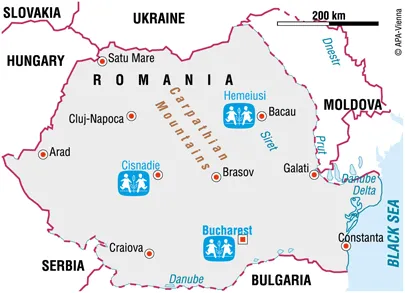
SOS relies on the kindness and generosity of Canadians to be able to provide a home for the most vulnerable children around the world.
SOS Children's Villages in Romania
SOS Children's Villages started working in Romania after the fall of Nicolae Ceausescu in 1989. The appalling conditions of Romanian orphanages were reported worldwide: the children were malnourished, badly cared for and living in terrible conditions.
Two SOS Children's Villages were built and the children were able to move into their new homes with their SOS families in 1993. SOS Children's Villages has continued to work in the country, supporting children, young people and families in three locations in the country. At present there are three SOS Children's Villages in Romania, three SOS Youth Facilities and three SOS Social Centres.

People in search of a better life
In the decade following the overthrow of Ceausescu, the country's economy declined. Recovery started in 2000, and in 2006 the country recorded one of the highest growth rates in gross domestic product in Europe. Once again the economy suffered during the 2009 recession, but made a slow recovery in later years. The current per capita gross domestic product is just over 40 per cent of the EU average.
Although 30 per cent of the population still lives under the nationally-established poverty line, this figure is beginning to improve. The poverty rate is higher in rural areas than in urban ones, and there are big regional differences.
At present the unemployment rate is 7.5 per cent (2013 est.). Agriculture employs 30 per cent of the population, industry 23 per cent and services 47 per cent.
In spite of the improving standard of living, many people are moving abroad. The promise of a better life in another country lures many people into the hands of human trafficking organisations. Since 2008, Romania has become the largest supplier of sex workers to other EU countries.
The health system is facing challenges: not only is it experiencing budget cuts but also corruption and shortage of drugs and staff - the latter form a significant percentage of those emigrating abroad in search of better working conditions. Parents who move abroad often leave their children behind, in most cases in the care of relatives. In 2008 over 96,000 cases were reported.
One per cent of the population has HIV/AIDS. Most of these cases are children who were brought up in the Romanian orphanages in the 1980s. Orphanage staff would inject blood as a food substitute. The syringes were not changed and with some contaminated blood, the disease spread quickly. At present the epidemic is believed to be spreading quickly through drug use and sexual transmissions - the most vulnerable groups are sex workers, street children and homeless adults and those addicted to heroin.
Children are in need of protection
There are just under four million children under the age of 18 in Romania. According to the United Nations about 32,000 children under the age of 14 are involved in child labour.
The children of Romania have been affected by the recent economic, social and political changes. As parents have struggled to find employment, there has been an increase in poverty. Children living in these families sometimes face precarious situations such as labour exploitation, violence, and domestic violence. Many are ultimately taken into care.
The general cuts in public spending have affected children due to less investment in education and in health provision. The country continues to score low in the international Program for International Student Assessment (PISA). The under-five mortality rate stands at nearly three times the EU average. The funding of services, and their quality, varies according to location. Staff turnover is also a problem in these sectors, partly because of low wages.
Despite planned measures to provide support to families, the percentage of children taken into care has remained the same over the past ten years. Small children – under the age of three – constitute the group who are most taken into care. Children with disabilities are routinely placed in institutions or with foster care; the reintegration into their family is difficult.
Our Impact
Image
The SOS Children's Village in Romania provides loving homes to orphaned and abandoned children |
3 VILLAGES | 172 Orphaned and Abandoned Children |
Image
The SOS Youth Facilities in Romania provides youth with a loving environment where they learn to transition into independent living and to expand their education |
8 YOUTH FACILITIES | 104 Youths in our Care |
Image

SOS Social Centres in Romania aim is to help families, in particular women and children, living in communities neighbouring the SOS Children's Villages to gradually escape from poverty, and to help young people become self-reliant. |
6 SOCIAL CENTRES | 741 Beneficiaries |
Our Impact






